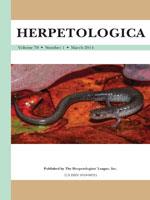We report a detailed account of the structure and dynamics of five populations of Ringed Salamanders (Ambystoma annulatumCope, 1886) in Missouri, USA, studied over a 4-yr period. The average date of capture for breeding males varied from 30 August to 2 October, and average date of capture for breeding females varied from 9 September to 7 October. The sex ratio was consistently male biased and averaged 2.05 males to each female. The smallest breeding female was 77 mm snout–vent length ([SVL]; mean = 96.3 mm) and the smallest breeding male was 66 mm SVL (mean = 94.2 mm). Eggs and larvae were present in September and October each year, and the larval period varied from 7 to 9 mo. Juveniles metamorphosed in all years in every pond, albeit in low numbers (6–631). The mean SVL of metamorphosing juveniles among all years and ponds was 39.2 mm. Intra-annual body size of emerging juveniles declined over time; juveniles that metamorphosed early were larger in body size than those metamorphosing later in the summer. Production of juveniles per female averaged 0.76 (range, 0.056–2.929), and survival of juveniles from egg to metamorphosis averaged 0.2% (range, 0.01%–0.75%). Both females and males can reach reproductive maturity at 1 yr of age, but most return at 2–3 yr of age. Management of the Ringed Salamander must focus on all life-history stages; protecting the aquatic stage to maximize the number and fitness of metamorphosing juveniles, managing the terrestrial habitat to maximize survival to first reproduction, and monitoring connectivity to promote metapopulation dynamics.
How to translate text using browser tools
1 March 2014
Structure and Dynamics of Ringed Salamander (Ambystoma annulatum) Populations in Missouri
Raymond D. Semlitsch,
Thomas L. Anderson,
Michael S. Osbourn,
Brittany H. Ousterhout
ACCESS THE FULL ARTICLE

Herpetologica
Vol. 70 • No. 1
March 2014
Vol. 70 • No. 1
March 2014
body size
Breeding migration
Juvenile production
maturity
Ozark Highlands
population size
sex ratio




